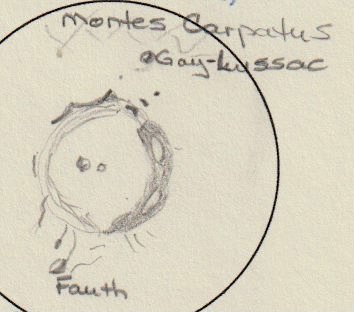IWLOP #095 - Copernicus
A prominent crater that is the prototype of the Copernican geological period. Copernicus features spectacular central peaks and is surrounded by both a prominent ejecta blanket and numerous secondary craters. The impact that formed Copernicus occurred about one billion years ago. It is easily visible in binoculars, particularly when near the terminator, and is by far the most prominent feature in the otherwise mostly flat Mare Insularum.
Location: 9.7 N 20.0 W Origin: Impact Size: 93 km. Rukl: 31 Type: Complex Crater (CC)
Objects: Copernicus, Kepler, Tycho
Others Identified: Fauth, Guy-Lussac
Observation 1:
Location: Home
Date: 2019-03-20
Time: 9:16 PM ADT
Equipment: 10” Meade SCT, 10 mm eyepiece
Magnification: x250
Seeing: Very Good (4)
Transparency: Very Good (4)
R2: The Copernican rays extend half way into Mare Imbrium, eastward into Mare Vaporum via Sinus Aestuum, NW through Montes Carpatus to Aristarchus. They overlap Kepler in the west.
C1: Did not complete this challenge in either observing session 1 or 2.
C2: Copernicus has a large number of shorter, overlapping rays, leaving the impression of a squashed tarantula. Whereas Copernicus' rays extend over the NW quadrant of the Moon, Tycho's rays extend over most of this side of the Moon, from the SW limb, NW to Mare Cognitum, Down to Mare Australe, NE into Mare Serenitatis, E to Mare Nectaris and Asperitatis. In essence, Tycho's rays cover a little over half the surface we see.
|
Observation 2: R1: Copernicus and Montes Carpatus were well lit near the terminator. The Copernican floor had 2 peaks centrally located. Floor and walls very well illuminated. Could see ridges on the west wall and highlights of tall ridges on the east rim. |
|
